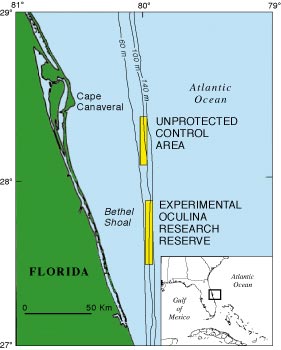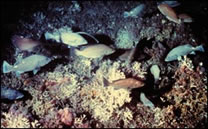 The
Oculina Banks extend from Fort
Pierce to Cape Canaveral off the eastern coast of Florida. The most predominate
coral species present is Oculina varicosa, the ivory tree coral. The reefs
span over 90 nautical miles, at depths ranging from 70-100 meters, and
represents the only colony of deep water O. varicosa on earth (Reed, 2002).
The colonies provide valuable habitat for a variety of fish species, including
the economically important snapper/grouper fishery. However, as fishing
pressures have increased impacts to the habitat, landings have rapidly
declined over the last twenty years (Koenig et al., 2000). The
Oculina Banks extend from Fort
Pierce to Cape Canaveral off the eastern coast of Florida. The most predominate
coral species present is Oculina varicosa, the ivory tree coral. The reefs
span over 90 nautical miles, at depths ranging from 70-100 meters, and
represents the only colony of deep water O. varicosa on earth (Reed, 2002).
The colonies provide valuable habitat for a variety of fish species, including
the economically important snapper/grouper fishery. However, as fishing
pressures have increased impacts to the habitat, landings have rapidly
declined over the last twenty years (Koenig et al., 2000). 
In response to these trends, the South
Atlantic Marine Fisheries Council has implemented a series of regulations,
which began with the establishment of a Habitat Area of Particular Concern
in 1984. In 1994 this area was designated as the Experimental Oculina
Research Reserve (EORR), and all commercial fishing practices where
banned for a period of ten years. The ban includes all trawling and
bottom fishing activities. In 1998, the boundaries of the EORR were
extended to include an additional  60
square miles of benthic habitat. The extension of the reserve came as
a result of the amendments to the Magnuson-Stevenson Fisheries Management
Act in 1996, which stated that Essential Fish Habitats (EFH’s)
must be identified in impacted areas to enhance overall conservation. 60
square miles of benthic habitat. The extension of the reserve came as
a result of the amendments to the Magnuson-Stevenson Fisheries Management
Act in 1996, which stated that Essential Fish Habitats (EFH’s)
must be identified in impacted areas to enhance overall conservation.
|





 The
Oculina Banks extend from Fort
Pierce to Cape Canaveral off the eastern coast of Florida. The most predominate
coral species present is Oculina varicosa, the ivory tree coral. The reefs
span over 90 nautical miles, at depths ranging from 70-100 meters, and
represents the only colony of deep water O. varicosa on earth (Reed, 2002).
The colonies provide valuable habitat for a variety of fish species, including
the economically important snapper/grouper fishery. However, as fishing
pressures have increased impacts to the habitat, landings have rapidly
declined over the last twenty years (Koenig et al., 2000).
The
Oculina Banks extend from Fort
Pierce to Cape Canaveral off the eastern coast of Florida. The most predominate
coral species present is Oculina varicosa, the ivory tree coral. The reefs
span over 90 nautical miles, at depths ranging from 70-100 meters, and
represents the only colony of deep water O. varicosa on earth (Reed, 2002).
The colonies provide valuable habitat for a variety of fish species, including
the economically important snapper/grouper fishery. However, as fishing
pressures have increased impacts to the habitat, landings have rapidly
declined over the last twenty years (Koenig et al., 2000). 

 60
square miles of benthic habitat. The extension of the reserve came as
a result of the amendments to the Magnuson-Stevenson Fisheries Management
Act in 1996, which stated that Essential Fish Habitats (EFH’s)
must be identified in impacted areas to enhance overall conservation.
60
square miles of benthic habitat. The extension of the reserve came as
a result of the amendments to the Magnuson-Stevenson Fisheries Management
Act in 1996, which stated that Essential Fish Habitats (EFH’s)
must be identified in impacted areas to enhance overall conservation.